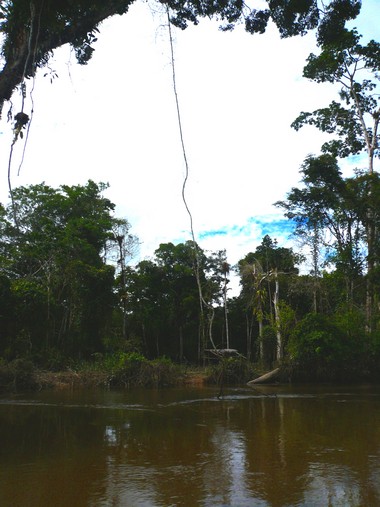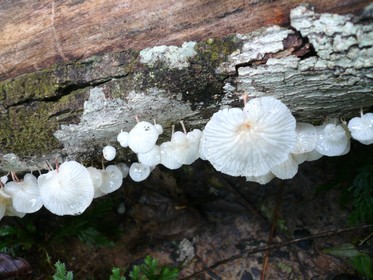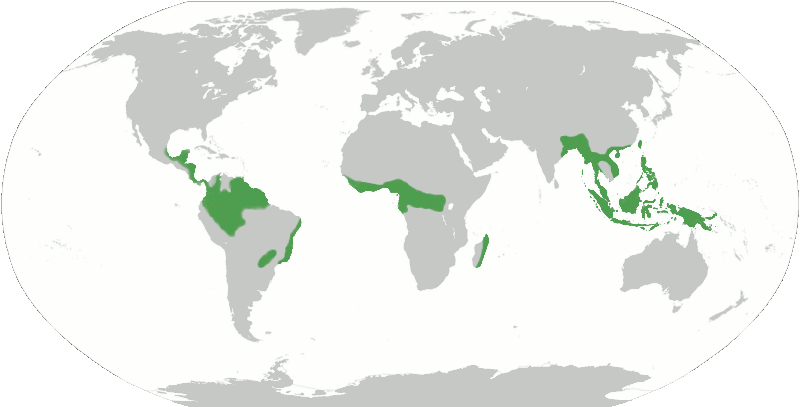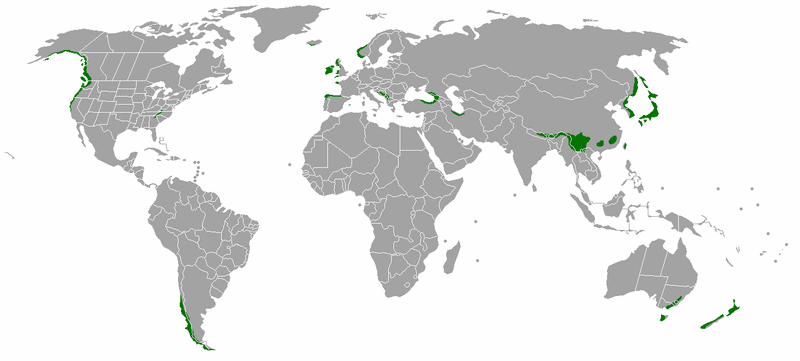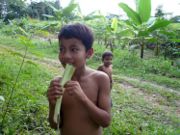Deforestation/Rainforest
| Module Two Objectives
|
Introductory Activity
| Wonderings
Reflect on (think about) the photo below, and discuss in a group what you see in the picture. Can you answer all the "I wonder ..." questions below?
|
What is a Rainforest?
Rainforests are dense jungles with tall trees and warm climates. The main reason that these forests are called rainforests, is because they receive such a large amount of rainfall every year. Most rainforests have an annual (yearly) rainfall of at least 203cm (80 inches), and some may even receive 2.5cm (one inch) or more of rainfall each day.
Rainforests have a great variety of animal, plant and fungal life. We call this variety of living things biodiversity. Although rainforests cover only 6% of the earth's surface, scientists believe that they are home to more than half of the earth's plant and animal species. These species often work and live closely together. The living together of two different species in a close relationship is called a symbiotic relationship. For example, in rainforests ants and fungi live symbiotically together, helping each other in the following way: fungi provide food for ants and, in turn, ants take care of and defend the fungi.
Where are Rainforests Found?
All rainforests are found in tropical regions where the sun is hot and shines about the same length of time each day throughout the year. This makes the climate warm and stable. There are many rainforests found in South and Central America, Australia, Asia and Africa. The Amazon Jungle, located in South America, is the largest rainforest in the world.
The Amazon Jungle
The Amazon Jungle is about the size of Australia and has the greatest biodiversity of all rainforests. Twenty percent of all birds and plants and ten percent of all mammals are found there. It is also home to the largest number of tribal or indigenous people. The Amazon River is the longest river in the world. Its length is 6,750 km.
Each year the Amazon loses roughly 51 000 square kilometres of vegetation due to deforestation.
| Activity One: Rainforest locations
In groups of four (unless otherwise stated by your teacher), collaborate to answer the questions provided below. Each group will be supplied with one atlas, one world map depicting tropical rainforests, and one world map depicting temperate rainforests. Study the maps and read the information provided in the atlas on rainforests; you may also utilise the Internet as an additional resource, if available. Note that this is a timed activity - your teacher will notify you of the allotted time you have available to complete this activity. Tropical Rainforests around the world
2. Approximately what percentage of the world would you say is covered in rainforests? 3. Name two countries from each continent in which rainforests are found. 4. In what continent is the Amazon River located? 5. List at least two countries through which the Amazon River Basin flows. 6. What is the size of the Amazon Rainforest? 7. What is the length of the Amazon River?
|
| Activity Two: Time for the complete deforestation of the Amazon
Find out how many years it will take for the Amazon to be completely destroyed. Procedure
|
The Layers of a Rainforest
Tropical rainforests are divided vertically into five layers. So if you draw an imaginary line down from the top of a tree (the crown) to the ground, your line will pass through all five of the layers. The animal and plant life found in each of these layers is different. The five layers, from the highest to the lowest, are:
- The overstory: the tops of the trees (crowns) that rise much higher above the rest of the trees.
- The canopy: the dense layer of closely growing and intertwining branches and leaves.
- The understory: the less dense layer of smaller and younger trees growing underneath the canopy.
- The shrub layer: the very young trees and shrubs that only grow up to an average of 6 metres (20 feet) above the forest floor.
- The forest floor: the lowest layer (ground layer) of the forest made up of low-growing plants and fungi.
It is not always possible to easily tell the different layers apart – rather like the colours of a rainbow. Also, not all rainforests have all of these layers and some forests have more layers than others; however these layers show us the basic structure of a rainforest.
The Importance of the Canopy
The canopy is home to most animal and plant life found in the forest. These animals are specifically adapted to living in the canopy as it becomes a lot hotter and drier during the day compared to the lower layers of the forest. The billions of leaves that make up the canopy make it difficult for the animals to see far, so they have to change the way they communicate. They do this by calling loudly or using musical songs. Even during the evening, the rainforest is never quiet; instead different animals are awake and call each other.
The canopy also forms a protective shield for the lower layers of the fores,t by filtering the sun’s rays, blocking drying winds,serving as protection from heavy rainfall and controlling the climate. The canopy also provides shelter for many of the plants, and shelter and hiding places for many of the animals.
Photosynthesis
Like all living things, plants need food to stay alive. The leaves of the canopy (and of other plants) use the energy of the sun, Carbon Dioxide gas (CO2),Water (H2O) and a few minerals to make Glucose (plant food) and Oxygen (02). This is known as photosynthesis.
Chlorophyll is a green pigment (colour) found in the leaves that helps with the process of photosynthesis. As photosynthesis mainly takes place in the leaves, the leaves can be seen as the "food" factories of the trees and plants. The "food" that the trees and plants make is used to grow new cells and to produce energy for chemical processes. Some "food" is stored for later use.
The word equation for photosynthesis is:
Sun's energy + Carbon Dioxide + Water -> Glucose + Oxygen
| Activity Three: The layers of a rainforest
In a group, create a diagram of a rainforest on a large sheet of paper. You may choose to use any or a combination of the provided art materials to create either a drawing or a collage. Annotate (label) your diagram with the answers to the questions provided below. 1. Which layer receives the most sunlight? 2. Which layer is like a tent cover? 3. Which layer has the tendency to have more photosynthesis activity and why? 4. Name all the layers of the rainforest When completed, display in your class or school library.
|
| Activity Four: Photosynthesis
Collaborate (work together) in small groups to answer the questions listed below. You may include diagrams if you choose to. 1. In your own words, define photosynthesis. 2. What is needed for photosynthesis to occur? 3. Write the formulae for water, carbon dioxide and oxygen. 4. Where do humans get oxygen from? 5. What do plants breathe? 6. What is chlorophyll? 7. What colour is chlorophyll? 8.In which part of the plant does photosynthesis occur?
|
Plants and Animals of the rainforest
Not only do rainforests house more that 50% of all the plants and animals on the earth, but the tropical rainforest waters are the home to most of the world’s fresh water fish species. Also, more than 66% of all plant species grow in tropical rainforests. Many different and unusual animals live in all layers of the forest, from the smallest insects to large mammals. Because the canopy is made up of so many leaves that are photosynthesizing during the day, creating energy, there is an excellent source of food for these animals. In fact, there are so many species of animals in the rainforests because there is so much food available.
People of the Rainforest
Rainforests are home to millions of people. Scientists estimate that there are about 50 million indigenous people living in rainforests throughout the world, and some of these tribes have never seen anyone outside of the rainforest. In Brazil alone, there are 26 native tribes that live with little or no contact with the outside world. To protect these 'lost tribes' from being attacked or killed by loggers and/or miners, the Brazilian government uses heat sensing technology to trace their whereabouts.
The people of the rainforests rely on the forest for their food, shelter and medicines. However, very few of these indigenous people live the way they used to. The outside world has changed the way they live, so instead of living off the forest, they now grow crops and travel often to nearby cities and towns to sell their crops and to buy Western goods.
| Activity Five: Human Dependence on Rainforests
The people of the rainforests rely on the forests for every aspect of their daily lives. These aspects can be categorised accordingly: food, medicine, recreation and shelter.
|
Summary
| Assessment One: Poster
Your teacher will assign you to groups. In your groups, you will create a poster covering the answers to the questions below. Once you have been assigned a group, vote for a team leader, and an artist. The team leader is responsible for ensuring the activity is done and that members get an equal opportunity to contribute. The artist takes ownership of creating the poster. Re-read the provided notes, and then answer the questions below. The categories in the left-hand column of the table below are there to show what you are being assessed on. |
Questions
| Knowledge | List and describe the layers of the rainforest. |
| Comprehension | Explain the importance of the canopy layer. |
| Application | Use your understanding of the rainforest to create a set of criteria needed for trees to survive in the rainforest. |
| Analysis | Explain how and why photosynthesis is different at the different layers of the rainforest. |
| Synthesis | Explain the effect the removal of the canopy would have on the lives of the people living in the forest. |
| Evaluation | Predict what would happen to the animals that live in the rainforest if the trees were cut down. |
| Assessment Two: KWL Chart
Return to the KWL chart. As you have now reached the end of Module Two, read through all your additions to your KWL chart - can you add anything more? Have you gained any knowledge that helps you answer your big question? Fill in any answers on your KWL chart and add any new information or new questions that have come up, in order to see if deforestation is good or bad for a community. |
|
